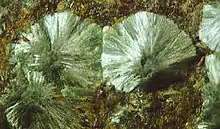Pumpellyite
Pumpellyite is a group of closely related sorosilicate minerals:
- pumpellyite-(Mg): Ca2MgAl2[(OH)2|SiO4|Si2O7]·(H2O)[3]
- pumpellyite-(Fe2+): Ca2Fe2+Al2[(OH)2|SiO4|Si2O7]·(H2O)[4]
- pumpellyite-(Fe3+): Ca2(Fe3+,Mg,Fe2+)(Al,Fe3+)2[(OH,O)2|SiO4|Si2O7]·H2O[5]
- pumpellyite-(Mn2+): Ca2(Mn2+,Mg)(Al,Mn3+,Fe3+)2[(OH)2|SiO4|Si2O7]·(H2O)[6]
- pumpellyite-(Al): Ca2(Al,Fe2+,Mg)Al2[(OH,O)2|SiO4|Si2O7]·H2O[7]
| Pumpellyite | |
|---|---|
 A sample of pumpellyite | |
| General | |
| Category | Sorosilicate |
| Strunz classification | 9.BG.20 |
| Crystal system | Monoclinic |
| Crystal class | Prismatic (2/m) (same H-M symbol) |
| Space group | A2/m |
| Identification | |
| Color | Olive green to bluish green |
| Cleavage | Good in two directions |
| Fracture | Uneven |
| Tenacity | Brittle |
| Mohs scale hardness | 5.5-6 |
| Luster | Vitreous, dull |
| Streak | White |
| Diaphaneity | Translucent |
| Specific gravity | 3.2 |
| References | [1] [2] |
Pumpellyite crystallizes in the monoclinic-prismatic crystal system. It typically occurs as blue-green to olive green fibrous to lamellar masses. It is translucent and glassy with a Mohs hardness of 5.5 and a specific gravity of 3.2. It has refractive indices of nα=1.674–1.748, nβ=1.675–1.754 and nγ=1.688–1.764.
Pumpellyite occurs as amygdaloidal and fracture fillings in basaltic and gabbroic rocks in metamorphic terranes. It is an indicator mineral of the prehnite-pumpellyite metamorphic facies. It is associated with chlorite, epidote, quartz, calcite and prehnite.
It was first described in 1925 for occurrences in the Calumet mine, Houghton Co., Keweenaw Peninisula, Michigan and named for United States geologist, Raphael Pumpelly (1837–1923).[8]
See also
References
- Mineralienatlas
- Chesterman, Charles W. (1978). The Audubon Society field guide to North American rocks and minerals. New York: Alfred A. Knopf. p. 567. ISBN 0394502698.
- Mindat - Pumpellyite-(Mg)
- Mindat - Pumpellyite-(Fe2+)
- Mindat - Pumpellyite-(Fe3+)
- Mindat - Pumpellyite-(Mn2+)
- Mindat - Pumpellyite (Al)
- Huber, N. King (1975). The Geologic Story of Isle Royale National Park, USGS Bulletin 1309. Washington: U.S. Government Printing Office. p. 58.